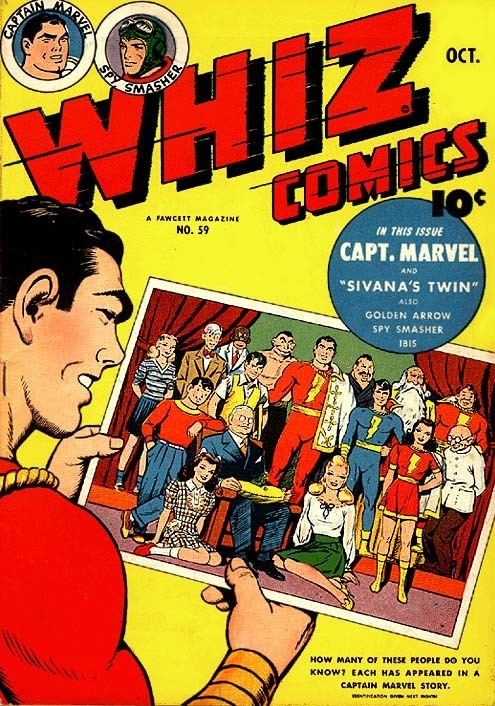Former type Comic publisher Products Comics Ceased operations 1980 | Industry Publishing Defunct 1980 Founded 1939 | |
 | ||
Headquarters New York City, New York, United States | ||
Fawcett Comics, a division of Fawcett Publications, was one of several successful comic book publishers during the Golden Age of Comic Books in the 1940s. Its most popular character was Captain Marvel, the alter ego of radio reporter Billy Batson, who transformed into the hero whenever he said the magic word "Shazam!".
Contents
Other characters published by Fawcett include Captain Video, Hopalong Cassidy, Ibis the Invincible, Bulletman and Bulletgirl, Spy Smasher, Captain Midnight, Phantom Eagle, Mister Scarlet and Pinky, Minute-Man, Commando Yank and Golden Arrow.
Aside from the better known superhero books, Fawcett also published a short-lived line of horror comics during the early 1950s, a string of titles which included This Magazine Is Haunted, Beware! Terror Tales, Worlds of Fear, Strange Suspense Stories, and Unknown World. Other genres included teenage humor (Otis and Babs), funny animal (Hoppy the Marvel Bunny), romance (Sweethearts), war (Soldier Comics) and Western (Lash LaRue, Six Gun Heroes). Fawcett also produced comics based on contemporary movie stars (Tom Mix, Monte Hale) and matinee serials (Nyoka the Jungle Girl). The entire line was dropped in 1953, when Fawcett closed down their comics publishing wing (though many titles were picked up by Charlton Comics [see below]).
History
Fawcett Publications began in 1919 with the magazine Captain Billy's Whiz Bang and eventually expanded into a line of periodicals with a combined circulation of ten million a month. The company joined in the explosion of comic book publications in the United States in the late 1930s and early 1940s. Its initial entry, developed by writer Bill Parker and artist C. C. Beck, was Thrill Comics, a single issue of which was published only as an ashcan copy. The content was then reworked (for example, the lead character of Captain Thunder was renamed to Captain Marvel) and published as Whiz Comics #2 (Feb. 1940).
In addition to Beck, the line-up of artists who contributed to Fawcett Comics include Al Allard, Harry Anderson, Ken Bald, Phil Bard, Al Bare, Dan Barry, John Belfi, Dave Berg, Jack Binder, Alex Blum, Bob Boyajian, Bob Butts, Al Carreno, Joe Certa, Nat Champlin, Pete Costanza, Greg Duncan, Leonard Frank, Bob Fujitani, Till Goodson, Ray Harford, John Jordan, H. C. Kiefer, Jack Kirby, Andre Le Blanc, Charles Nicholas, Carl Pfeufer, Mac Raboy, Pete Riss, Ed Robbins, John Rosenberger, Kurt Schaffenberger, Joe Simon, Jon Small, Ed Smalle, Jack Sparling, John Spranger, Chic Stone, Charles Sultan, Marc Swayze, Ben Thompson, George Tuska, Bill Ward, Clem Weisbecker, Burt Whitman, Reuben Zubofsky and Nick Zuraw.
The whimsical adventures of Captain Marvel and the Marvel Family (which included Captain Marvel, Jr., Mary Marvel, the Lieutenants Marvel, etc.) eventually outsold those of Superman. National Comics (as DC Comics was then known) sued Fawcett, claiming that the Captain infringed on the copyright of their original costumed superhero. National Periodical's 1941 copyright hearing against Fawcett was dismissed on a technicality; National had failed to secure the copyright to the Superman newspaper strip.
Facing a declining comics market, in 1953 Fawcett Comics ceased publication of its superhero titles and settled the ongoing case (the non-comic book divisions of Fawcett continued to publish). Several of Fawcett's completed stories and artwork, as well as a few characters, were sold to Charlton Comics. Fawcett returned to publishing comics in the 1960s but mainly to publish Dennis the Menace and other such titles.
In the late 1960s Marvel Comics gained the trademark "Captain Marvel" with their first series. In 1972 DC licensed — and in 1994, purchased — Captain Marvel and his related characters. Because of Marvel's trademark, DC has instead used the trademark Shazam! as the title of their Captain Marvel-related comic books and thus the name under which they market and promote the character. In 1973, Shazam and the Marvel family became an additional Earth (to the Pre-Crisis DC continuity), known for a period of time as Earth-S.
